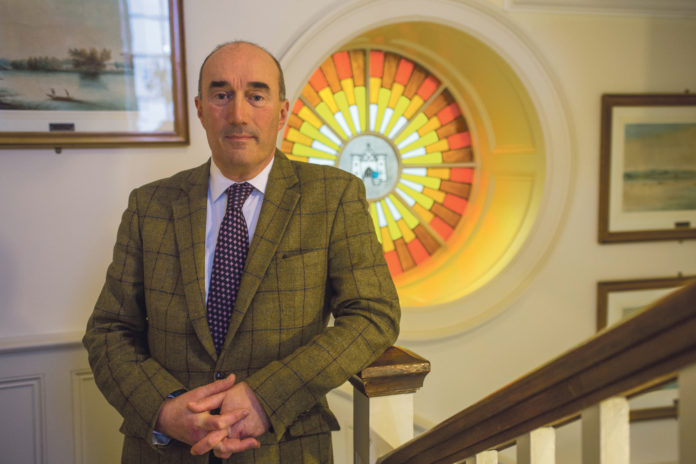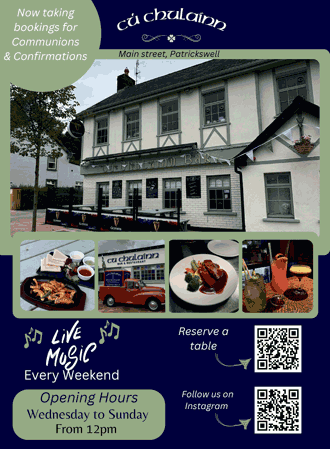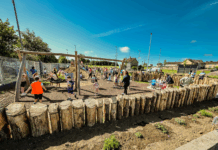
THE three storey landmark building is heavy with histories, artefacts, cabinets of militaria, the residue of posh Limerick estates and collections such as those of House of Armstrong and the House of Carroll.
This is Limerick Civic Trust, its work and props at the sprawling organisation’s principal base, Bishops’ Palace on Castle Street.
An embroidered dress suit that belonged to Emperor of Spain Joseph Bonaparte – “one of the most vile and inhumane people who ever lived” – is part of the magnificent lore.
In the 21st century Treaty City, the keeper of the dress suit is David O’Brien, chief executive officer of the Trust.
In this reclaimed part of King’s Island, Bishops’ Palace fronts the emerging Limerick Military History Museum at St Munchin’s Church, currently being repurposed to have its conversion completed early next year.
Active since 1983, the Trust’s “sole purpose is the improve the environment we live in, which is a very big remit if you think about it.
“There were civic societies in Ireland before then but not Civic Trusts. We are the first, the oldest and the biggest and most successful,” David O’Brien states categorically.
“For all the negative things that are said about Limerick, when you pull people out of the milieu … you get the best out of them and get the best that Limerick does.
“The membership of the Civic Trust has constantly been there for the executive, taking up the cudgels for what needs to be done and just given it all.”
Work undertaken by LCT is categorised across the environment – architecture, streets and heritage; and the education and cultural environment.
“The example of that is our lecture series every year. It is designed and directed towards bringing people into Limerick to talk to us, not talking to ourselves, on key subjects and issues that will impact on the environment.”
Members have welcomed past speakers such as Web Summit’s Paddy Cosgrave; prominent peacekeeper Colm Doyle and top European urban planner Peter Bishop.
Autumn 2019’s series will be held in St Munchin’s Church, Kings Island. “Our opening speaker this year should be Richard Thornhill, deputy editor of The Financial Times. He will be moderated by an old friend of the Trust, Quentin Peel, formerly of Chatham House.”
The urbane O’Brien invokes the duty to “gather, protect and hoard… the papers and documents that support Irish history.
“The great tragedy of Irish history is the pages that are often torn out and what we try to do is put them back in where we can.
“The beauty about Irish history is that there is no black and white. We have a fantastic kaleidoscope of colour and to see a black and white history of ‘us and them’ is to deny yourself the opportunity to know the facts.”
The various missions of Limerick Civic Trust go back to the late, great Denis Leonard as founding executive. He got together with Seamus Gubbins, Paddy Hoare and others to buy The Bishops’ Palace, then a derelict home that the Council wanted knocked, for £1000 punts. They set up shop.
“This place was roofless” and now, gracious floors are weighted with cultural riches. Book a walking tour online of Trust sites to appreciate the architectural finesse and the stories they house, as with No. 2 Pery Square. The building formerly known as Culture House will be leased to LCT for a €1 annually by Limerick Council.
Working on these current projects are 75 people, “69 individuals on the Community Employment Scheme, the backbone of LCT, the Trust’s heroes.” Supervisors, administration and management make up the numbers.
It’s a tight ship. Nearby, there is much laughter and storytelling going on in the Church worked by experienced artisans.
“Our CES workers are here, not as an alternative to being unemployed but because this is what they want to do. They don’t want to sit at home watching ‘Oprah’.”
There are smaller teams at Limerick FC grooming Markets Field, more at the three bridges, others on the Wetlands.
How is the Trust funded?
“We have 150 contributing members who give whatever they can and 300 full members who pay and who are asked to contribute to different things. People give what they can and longer serving members give an awful lot more, their time and expertise to committees and so on.”
“We have far too little funding, there is never enough.” His point is made time and time again as the organisation is active in multiples such as the maintenance on 14 historic graveyards, the Milk and Potato Markets, St Patrick’s Festival, Team Cleanup Limerick, Markets Field and street by street power-hosing weekly.
More than 30 volunteers are core to works and donations are essential at https://www.limerickcivictrust.ie/make-a-donation
The custodian of times past
THERE is a bugbear: “The proliferation of plaques around town.”
David O’Brien wants to introduce specific criteria to ensure that a plaque is imbued with due respect for heritage.
He uses the analogy of Keith Wood’s legacy to explain why.
Given his way, the Civic Trust chief executive would erect a plaque for the rugby hero’s carrying of four Englishmen over the line to score a try for his country. His young son would have the plaque put up for Killaloe’s Clarisford Park which Keith has helped develop for sporting and community activities.
Ideally, the new terms for a plaque would be?
“That someone would be dead for 30 years first. That they would have been born about a 100 years ago or more. And hopefully, that the place where the plaque is sited would have a meaningful connection to them. “
Working variously in publishing and print in the 1990s, David O’Brien went on to lead the Scottish Holdings takeover of some of the bastions of local Irish media, including Limerick radio.
“It was an awful lot of fun,” he recalled.
School was St Michael’s NS, Pery Square and St Munchin’s.
Today he has a 21 year-old daughter in Strathclyde University and two children at home in Killaloe.
He has the cut of the ‘huntin’, tootin’, fishin’ class about him, bounding up and down Georgian tiers at Bishops’ Palace to showcase the prime collections. Among them are objects from historian James McMahon’s estate, and signed guest books from Dromore Castle: “You would not believe who was staying around Limerick then.”
Everything he communicates about Civic Trust and worthy works in progress lights him up, stuff like the donated boxes of military regalia in the attic.
Downtime in Limerick?
Long pause. “I love the Milk Market. That really is the weekly event, the must-do.” For eating out, “Wood and Bell in Killaloe. I love Sash in Pery Square.”
Kitesurfing is a new sports figary.
Bringing Limerick history to life is his greater story. At the church/ museum, he tells the story of the only World War artefact given by Britain to Ireland, the winding oak staircase that made with Castleconnell oak, had found itself built in to a Cirencester hospital. Today it is polished eloquence, a hardy survivor supporting history’s joists, as is the case with Limerick Civic Trust.










